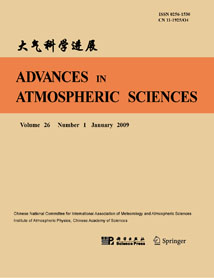| [1] |
HUANG Ping, WANG Pengfei, HU Kaiming, HUANG Gang, ZHANG Zhihua, LIU Yong, YAN Bangliang,
2014: An Introduction to the Integrated Climate Model of the Center for Monsoon System Research and Its Simulated Influence of El Nio on East Asian-Western North Pacific Climate, ADVANCES IN ATMOSPHERIC SCIENCES, 31, 1136-1146.
doi: 10.1007/s00376-014-3233-1
|
| [2] |
Jianping LI, Fei ZHENG, Cheng SUN, Juan FENG, Jing WANG,
2019: Pathways of Influence of the Northern Hemisphere Mid-high Latitudes on East Asian Climate: A Review, ADVANCES IN ATMOSPHERIC SCIENCES, 36, 902-921.
doi: 10.1007/s00376-019-8236-5
|
| [3] |
JIANG Dabang, DING Zhongli, Helge DRANGE, GAO Yongqi,
2008: Sensitivity of East Asian Climate to the Progressive Uplift and Expansion of the Tibetan Plateau Under the Mid-Pliocene Boundary Conditions, ADVANCES IN ATMOSPHERIC SCIENCES, 25, 709-722.
doi: 10.1007/s00376-008-0709-x
|
| [4] |
FANG Yongjie, ZHANG Yaocun, HUANG Anning, LI Bo,
2013: Seasonal and Intraseasonal Variations of East Asian Summer Monsoon Precipitation Simulated by a Regional Air-Sea Coupled Model, ADVANCES IN ATMOSPHERIC SCIENCES, 30, 315-329.
doi: 10.1007/s00376-012-1241-6
|
| [5] |
LIU Bin, GUAN Changlong, Li'an XIE, ZHAO Dongliang,
2012: An Investigation of the Effects of Wave State and Sea Spray on an Idealized Typhoon Using an Air--Sea Coupled Modeling System, ADVANCES IN ATMOSPHERIC SCIENCES, 29, 391-406.
doi: 10.1007/s00376-011-1059-7
|
| [6] |
ZHOU Xiaomin, LI Shuanglin, LUO Feifei, GAO Yongqi, Tore FUREVIK,
2015: Air-Sea Coupling Enhances the East Asian Winter Climate Response to the Atlantic Multidecadal Oscillation, ADVANCES IN ATMOSPHERIC SCIENCES, 32, 1647-1659.
doi: 10.1007/s00376-015-5030-x
|
| [7] |
MAN Wenmin, and ZHOU Tianjun,
2014: Regional-scale Surface Air Temperature and East Asian Summer Monsoon Changes during the Last Millennium Simulated by the FGOALS-gl Climate System Model, ADVANCES IN ATMOSPHERIC SCIENCES, 31, 765-778.
doi: 10.1007/s00376-013-3123-y
|
| [8] |
Jing ZOU, Zhenghui XIE, Chesheng ZHAN, Feng CHEN, Peihua QIN, Tong HU, Jinbo XIE,
2019: Coupling of a Regional Climate Model with a Crop Development Model and Evaluation of the Coupled Model across China, ADVANCES IN ATMOSPHERIC SCIENCES, 36, 527-540.
doi: 10.1007/s00376-018-8160-0
|
| [9] |
Li Chongyin, Liao Qinghai,
1996: Behaviour of Coupled Modes in a Simple Nonlinear Air-Sea Interaction Model, ADVANCES IN ATMOSPHERIC SCIENCES, 13, 183-195.
doi: 10.1007/BF02656861
|
| [10] |
ZhouTianjun, Zhang Xuehong, Yu Yongqiang, Yu Rucong, Liu Xiying, Jin Xiangze,
2000: Response of IAP/ LASG GOALS Model to the Coupling of Air-Sea Fresh Water Exchange, ADVANCES IN ATMOSPHERIC SCIENCES, 17, 473-486.
doi: 10.1007/s00376-000-0037-2
|
| [11] |
ZENG Xinmin, ZHAO Ming, SU Bingkai, TANG Jianping, ZHENG Yiqun, GUI Qijun, ZHOU Zugang,
2003: Simulations of a Hydrological Model as Coupled to a Regional Climate Model, ADVANCES IN ATMOSPHERIC SCIENCES, 20, 227-236.
doi: 10.1007/s00376-003-0008-5
|
| [12] |
Charlie C. F. LOK, Johnny C. L. CHAN, Ralf TOUMI,
2022: Importance of Air-Sea Coupling in Simulating Tropical Cyclone Intensity at Landfall, ADVANCES IN ATMOSPHERIC SCIENCES, 39, 1777-1786.
doi: 10.1007/s00376-022-1326-9
|
| [13] |
Jianhong WANG, Meiqi LI, X. San LIANG, Xing WANG, Feng XUE, Mo PENG, Chunsheng MIAO,
2018: Regional Characteristics of Typhoon-Induced Ocean Eddies in the East China Sea, ADVANCES IN ATMOSPHERIC SCIENCES, 35, 826-838.
doi: 10.1007/s00376-017-7173-4
|
| [14] |
WANG Xin, ZHOU Wen, LI Chongyin, WANG Dongxiao,
2012: Effects of the East Asian Summer Monsoon on Tropical Cyclone Genesis over the South China Sea on an Interdecadal Time Scale, ADVANCES IN ATMOSPHERIC SCIENCES, 29, 249-262.
doi: 10.1007/s00376-011-1080-x
|
| [15] |
FU Weiwei, ZHOU Guangqing, WANG Huijun,
2006: Modeling the Tropical Pacific Ocean Using a Regional Coupled Climate Model, ADVANCES IN ATMOSPHERIC SCIENCES, 23, 625-638.
doi: 10.1007/s00376-006-0625-x
|
| [16] |
YANG Yun, WU Lixin,
2015: Changes of Air-sea Coupling in the North Atlantic over the 20th Century, ADVANCES IN ATMOSPHERIC SCIENCES, 32, 445-456.
doi: 10.1007/s00376-014-4090-7
|
| [17] |
Congwen ZHU, Boqi LIU, Kang XU, Ning JIANG, Kai LIU,
2021: Diversity of the Coupling Wheels in the East Asian Summer Monsoon on the Interannual Time Scale: Challenge of Summer Rainfall Forecasting in China, ADVANCES IN ATMOSPHERIC SCIENCES, 38, 546-554.
doi: 10.1007/s00376-020-0199-z
|
| [18] |
Zhu Congwen, Chen Longxun, Nobuo Yamazaki,
1999: The Interdecadal Variation Characteristics of Arctic Sea Ice Cover-ENSO-East Asian Monsoon and Their Interrelationship at Quasi-Four Years Time Scale, ADVANCES IN ATMOSPHERIC SCIENCES, 16, 641-652.
doi: 10.1007/s00376-999-0038-8
|
| [19] |
Marco Y.-T. LEUNG, Dongxiao WANG, Wen ZHOU, Yuntao JIAN,
2023: Extended Impact of Cold Air Invasions in East Asia in Response to a Warm South China Sea and Philippine Sea, ADVANCES IN ATMOSPHERIC SCIENCES, 40, 531-540.
doi: 10.1007/s00376-022-2096-0
|
| [20] |
Zhou Tianjun, Yu Rucong, Li Zhaoxin,
2002: ENSO-Dependent and ENSO-Independent Variability over the Mid-Latitude North Pacific: Observation and Air-Sea Coupled Model Simulation, ADVANCES IN ATMOSPHERIC SCIENCES, 19, 1127-1147.
doi: 10.1007/s00376-002-0070-4
|















 AAS Website
AAS Website 
 AAS WeChat
AAS WeChat 
 DownLoad:
DownLoad: